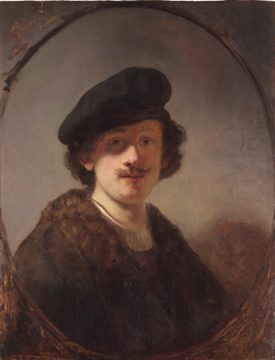Man in Jiffy-Pop Hat? Dude with ‘Tude? Grade-school wit is so contagious, it’s hard to resist inventing mock titles for such a puerile painting. If Dude is an image, rather, of a Russian “boyar,” or nobleman, as put forth by the Rembrandt Research Project, then surely this is a send-up of an aristocrat and not a serious picture.

I see more Chef Boyardee than boyar in this poor fool whose cheap ensemble, including the pompous van dyke, looks fresh off the rack at Party City. It’s a work of “laughable absurdity,” as one of the co-curators of Rembrandt in America, Tom Rassieur, described it.
Thank goodness Dude has been absorbed into the hand-rolled q-tips of deft restorers. It survives today as merely a photo, a thumbnail illustration on the wall label for Rembrandt’s beautiful Self-Portrait with Shaded Eyes.
It’s incredible to think that for almost 400 years, however, Dude successfully masked Shaded Eyes, which Rembrandt painted in 1634, at the height of his Amsterdam fame, when there was a market for his likeness. Once all the offending overpaint was removed–the last vestiges were lifted in 2002–and a stunning, original self-portrait of a 28-year-old Rembrandt emerged, the long-hibernating masterpiece sold for over $7M at auction, bought at the time by Las Vegas casino mogul (and English lit. major) Steve Wynn.
We sometimes hear about Old Master works of art being sloppily painted over to escape the eye of Nazi “collectors” in WWII, but this painting was intentionally disfigured only a few years after Rembrandt finished it, according to the Rembrandt Research Project, the venerable organization brought in to conduct tests on the outer paint layers and assess the possibility of there being something superb underneath. According to the world’s authority on Rembrandt and the head of the RRP, Ernst van de Wetering, “the overpaintings were so old one had to entertain the possibility that they had been done in Rembrandt’s own workshop.”
Seriously?
Rembrandt may have overseen this?

Perhaps–suggests Van de Wetering, in his Rembrandt: A Life in 180 Paintings–once the original self-portrait didn’t sell. The RRP speculates Rembrandt may have overestimated the market for his self-portraits, and when Shaded Eyes wasn’t purchased, it went back into his studio (where Rembrandt trained many apprentices) to be converted first into a more up-to-date image of the master and then into a tronie, a character study considered “very popular wall decoration in Rembrandt’s time.”
What’s equally fantastic is how the RRP’s expert restorers went about taking off the overpainting. “This is the most challenging type of restoration to pull off,” said NCMA conservator Noelle Ocon, “old oil paint over old oil paint.”
Refined removal takes place at the molecular level. Initially aided by x-radiographs and ultraviolet luminescence that help delineate layers, restorers work on a painting under a microscope “the way surgeons use ultrasound” and other advanced imaging technology. “Thousands of scientific and stylistic decisions go into what to leave on and what to take away.” It also helps that the chemicals restorers use aren’t what you’d apply to strip furniture. “My strongest solvent,” said Ocon, “won’t touch a coffee stain. Water is stronger.”
Death by subtle swabbing. Gone, after hundreds of years, are the trapped eyes and ridiculous whiskers. Revived is Rembrandt’s confident gaze, under brilliant shadow. And there’s a silver lining: such hubris kept the hidden masterpiece in fairly decent condition.
I went back through the exhibition the other day and paused before this self-portrait, one of three in Rembrandt in America, feeling lucky to see something so fresh and new to the world. Thank you, modern conservators, for the years you put into your training; your willingness, given your considerable talents, to live out of the limelight; and your scientific devotion to art.
We owe you.
Now, can you lift those devil horns I drew coming out of my math teacher’s head in my junior-high annual? He was a very smart man and certainly more patient than I was good at understanding coefficients. I’m no art historian; but I may be something of a sheepish expert in early disgruntled pupil, and I say it’s no mystery how Rembrandt lost his dignity. For a time.
